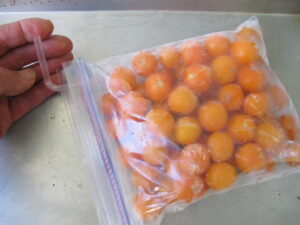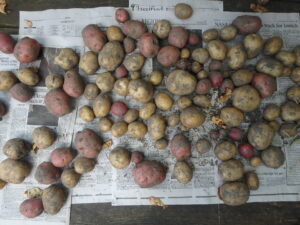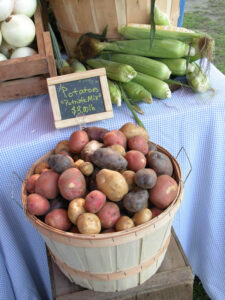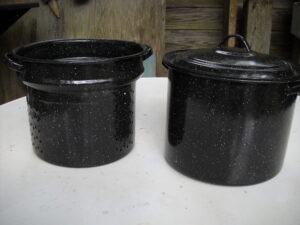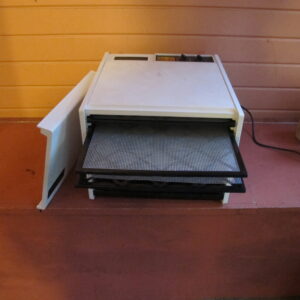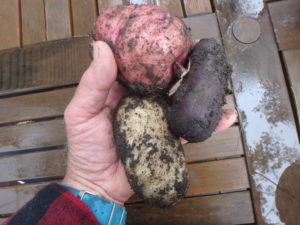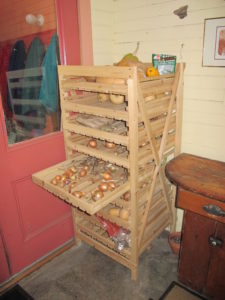Saving the Harvest
I keep tomato products for later use in a number of ways. First and easiest, I freeze tomatoes whole. I put clean tomatoes in zipper bags and freeze them whole. Later, when I want tomatoes for a soup or stew, I just run hot water from the tap into a big bowl and drop in a few tomatoes. That softens them up so I can easily chop them, but it also loosens the skins. I just rub the skins with my fingers, and skin comes off. A few minutes later I chop them and they are just like canned tomatoes.
I grow many hundreds of cherry tomatoes each summer. I plant a dozen or more ‘Sun Gold’ cherry tomato plants each year, and each produces a bounty of rich, golden nuggets of flavor. What do I do with all those? I cut them in half and dry them in a food dehydrator, cut side up. When dry they will keep well in the pantry (or the freezer) in a wide-mouth quart jar. I toss a handful into every soup or stew I make.
When digging potatoes or pulling onions, try to do it in a dry time (not hard this summer). Lower moisture levels are better for storage. Cure them for a few days in a breezy place out of the sun. Store potatoes, carrots, celeriac and rutabagas in a place between 35 and 50 degrees with high humidity. Garlic and onions like lower humidity with cool temperatures. Sweet potatoes should never go in the fridge – they need to be stored in a warm room like the kitchen.
Putting Away Veggies for Winter
Potatoes, carrots, kohlrabi, rutabagas, celeriac or celery root, turnips and parsnips will store for months at 35 to 50 degrees with high humidity. You can do that in a spare fridge, preferably in a drawer that keeps humidity in it. Or put them in zipper bags and punch a few breathing holes in the bags. You can put an inch of moist sand in a bucket, and store carrots in the garage if it stays cold, but not frigid. Keep a lid on the bucket, and check from time to time. Rodents love carrots and potatoes, so you can’t store them in an open container.
A full-sized freezer is a good investment. Among other things, tomatoes, corn, broccoli, beans, peppers, kale and fruit store well in a freezer. I freeze them in freezer-grade zipper bags. You can suck the excess air out of the bag with a drinking straw by closing the seal up to the straw, then pulling it out quickly and snapping shut while still sucking on the straw.
I also dehydrate foods, notably tomatoes, hot peppers, apples and pears. You can buy a good dehydrator like the ones made by Nesco American Harvest for somewhere under $150. Or you can buy the Cadillac of dryers and get an Excalibur for $300 or more. Those use less energy and dry the food evenly without having to rotate the trays.
I also make tomato paste and freeze it in ice cube trays. I often do this with imperfect tomatoes: I cut out the bad parts and put the rest in a Cuisinart to blend them into a loose “soup” that I then cook down slowly in a big enameled cast iron pot. When I can literally stand a spoon up in the mix, it is done. Having a supply of tomato paste is essential for cooking, and I like that I don’t have to open a can when I need just a little.
If you have an apple tree, you probably have already made some apple sauce this year. It freezes well, and is always tasty. But have you made cider? You don’t need to buy a cider press. I bring apples to my local orchard, and ask them to press and bottle the juice. Be sure to tell your orchardist that you are freezing it, and to leave an inch of space for expansion. They will charge you a fee, but it is well worth it for the satisfaction of having your own cider in winter.
It’s Time to Harvest and Store Root Crops
I sometimes wonder if I’m part squirrel. No, I don’t bury acorns for winter, but I do love putting up food for winter, especially potatoes. They’re the ultimate “comfort food” as far as I am concerned, and I rarely have too many. If you haven’t already done so, now is the time to harvest and store your potatoes for winter.
If you haven’t dug your potatoes yet, don’t worry. Potatoes store well in on ground right up to frost, and even after frost. But don’t try to overwinter them in the ground – they’ll get soft and unappealing. By now the leaves on my potato plants have yellowed and begun to die back, so there is no point in waiting- they won’t get any bigger. And if I wait too long, the mice may find them.
It’s important to be careful when digging potatoes so that you don’t damage any. I use a potato fork that has been in my family for decades. It’s like an ordinary garden fork, but the tines are at a right angle to the long handle, and are sharp and long. To harvest I pull the soil to one side with the potato rake. Then I plunge my fingers into the loose soil to find the spuds. If I spear a potato it goes into a pile destined for immediate consumption.
It is generally accepted that one should not wash potatoes fresh from the soil. Their skins are soft and easily damaged right after digging them. Most experts suggest hardening the skins by spreading them out in a cool place out of the sun for about a week. I do this on a north-facing deck, and turn over the potatoes after 2 or 3 days so both sides get hardened off.
Storing potatoes is best done by keeping them in a dark location with high humidity that stays between 35 and 50 degrees. Storing them in a warmer place will turn some of the starches in the potatoes into sugars. This will cause the potatoes to burn easily if you make French fries, so commercial growers keep them cool.
Potatoes need to breathe while in storage. They are living organisms that respire, so putting them in a sealed plastic bag will suffocate them, ruining them. Traditionally potatoes were stored in a cool basement with a dirt floor, but losses to mice or rats was often a problem.
I have a cool basement with a cement floor, and I have built a box there to contain buckets of potatoes and other root crops. It consists of two layers of blocks arranged in a rectangle, three blocks long and two wide. On top I have a piece of half-inch plywood. I call this my cool box, or root cellar. It will hold 6 buckets at a time. And so far, the rodents have not found a way in.
Carrots store well in my cool box. Like potatoes, they need a cool humid location for storage. I put an inch of moist sand in the bottom of each bucket to keep up the humidity.
Unlike potatoes, however, carrots will store well in the ground. In the past I have covered my carrots in the garden with a layer of straw or hay, then leaves. This acts as insulation and keeps the ground from freezing, allowing me to go out, shovel away the snow, and dig carrots in winter. Mice or voles have been an occasional problem, however. I put a stake in the ground at each end of the carrot bed so that I can find it in deep snow.
What else stores well in my cool box? Rutabagas, kohlrabi and celeriac – three less common root crops that I like – all store well cool, with high humidity. But onions do not store well in my cool box. They like a cool environment, but low humidity.
I store my onions and garlic in an area near the mudroom that stays cool but dry. I use a wooden “orchard rack” that I got from Gardener’s Supply many years ago. I also use it for winter squash. It has 6 large slatted drawers that pull out, allowing me to select what I need for dinner. It has excellent air circulation.
An old Vermont farmer I knew stored his winter squash upstairs under the bed in the guest room. He said he kept the radiator turned off so the room stayed cold, but above freezing. The humidity is naturally low in winter in most houses.
Last but not least, I have an ancient General Electric refrigerator in the basement that is not “frost-free”. This vintage fridge does not remove the moisture the way modern ones do, so ice will sometimes build up, requiring me to defrost it. But any vegetable that stores well in high humidity will do much better there than in a modern fridge which creates low humidity except in the two drawers at the bottom.
Part of my joy in gardening is spending time outdoors growing flowers and vegetables. Each fall I get busy putting up the vegetables for use in the kitchen all winter. And each time I make a stew with food I grew, I know my food is chemical-free and it tastes better to me because I grew it.
Henry Homeyer is a UNH Master Gardener and the author of 4 gardening books. See his blog posts at https://dailyuv.com/



